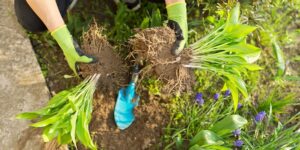September/October Garden Calendar
go.ncsu.edu/readext?817263
en Español / em Português
El inglés es el idioma de control de esta página. En la medida en que haya algún conflicto entre la traducción al inglés y la traducción, el inglés prevalece.
Al hacer clic en el enlace de traducción se activa un servicio de traducción gratuito para convertir la página al español. Al igual que con cualquier traducción por Internet, la conversión no es sensible al contexto y puede que no traduzca el texto en su significado original. NC State Extension no garantiza la exactitud del texto traducido. Por favor, tenga en cuenta que algunas aplicaciones y/o servicios pueden no funcionar como se espera cuando se traducen.
Português
Inglês é o idioma de controle desta página. Na medida que haja algum conflito entre o texto original em Inglês e a tradução, o Inglês prevalece.
Ao clicar no link de tradução, um serviço gratuito de tradução será ativado para converter a página para o Português. Como em qualquer tradução pela internet, a conversão não é sensivel ao contexto e pode não ocorrer a tradução para o significado orginal. O serviço de Extensão da Carolina do Norte (NC State Extension) não garante a exatidão do texto traduzido. Por favor, observe que algumas funções ou serviços podem não funcionar como esperado após a tradução.
English
English is the controlling language of this page. To the extent there is any conflict between the English text and the translation, English controls.
Clicking on the translation link activates a free translation service to convert the page to Spanish. As with any Internet translation, the conversion is not context-sensitive and may not translate the text to its original meaning. NC State Extension does not guarantee the accuracy of the translated text. Please note that some applications and/or services may not function as expected when translated.
Collapse ▲Plants in Flower
| Helenium/Sneezeweed | Japanese anemone |
| Rose-of Sharon/Hardy hibiscus | Butterfly bush |
| Dahlia | Bluebeard |
| Canna Lily | Tickseed |
| Chrysanthemum | Lavender |
| Crocus | White turtlehead |
| Liriope | Russian sage |
| Sedum | Sasanqua cammelias |
| Asters | Hardy lematis |
| Goldenrod | Crepe myrtles |
| Joe Pye Weed | Summer annuals |
Fertilizing
- September: See Lawn Care
- October: Spring-flowering bulbs at planting time with a balanced fertilizer
Planting
(September)
- Set out landscape plants. Shop early to find the nicest shrubs.
- When planting containerized plants in the landscape, make sure to break up the plants’ root ball, especially if it is pot bound.
- Set out new chrysanthemum plants this month.
- Plant pansies to add color to your yard in the autumn, winter, and spring months.
- Groundcovers will become well established if planted now.
- Transplant any evergreen trees or shrubs that need moving this month.
- Plant fall vegetables like mustard, onion, radish, and turnip.
(October)
- Plant spring-flowering bulbs like daffodil, tulip, crocus, and hyacinth.
- Continue setting out pansies, new plants perennials, or transplanting.
- If you don’t have a fall vegetable crop, plant cover crops like hairy vetch, winter rye, and crimson clover.
- Start salad vegetables in a cold frame & enjoy all winter. Plant lettuce, green onions, carrots, radishes, and most leafy greens inside cold frame.
Pruning
- Consider leaving seed heads of perennials like black-eyed Susan and coneflower as food for wildlife this winter!
- Do NOT prune shrubs in September or October.
- Remove “weed” or unnecessary trees from your landscape.
- Root-prune any trees or plants you plan to move next spring.
- Cut back any herbaceous perennials with spent flowers and after frost kills the tops.
Spraying
- Spray landscape shrubs for the following insect pests: arborvitae, hemlock, and juniper (spider mites), azalea and pyracantha (lace bug), and euonymus (scale)
- Spray for peachtree borer on your nectarine and peachtree trunks.
- Continue with rose spray program.
- Scout fall vegetable plants. Insects and diseases are more severe in the autumn.
- Control woody weeds by spraying the recommended herbicide.
- Store garden pesticides in a secured, dry location that will not freeze.
Lawn Care
- Take a soil sample!! Free analysis until December 1!
- Tall fescue and bluegrass lawns should be seeded in (September). Remember to mulch the newly seeded areas with wheat or barley straw. Keep watered.
- Fertilize and lime your tall fescue lawns according to soil test results (September).
- Do NOT fertilize zoysia now.
- Homeowners can apply an insecticide for lawn grubs in early September if needed.
- Keep tree leaves from collecting on your lawn.
Propagation
 Divide and replant perennials, spring-flowering bulbs & peonies (September–early October) once foliage begins to die back.
Divide and replant perennials, spring-flowering bulbs & peonies (September–early October) once foliage begins to die back.- Dig and divide rhubarb (October).
Specific Chores
- Clean up garden sprayers and lawn equipment if not in use.
- Prepare houseplants to reenter your home. Check them carefully for insect pests.
- If you do not have a fall vegetable garden, it is a good time to chop, burn, or discard dead vegetable plants.
- Start filling your compost bin as leaves begin to fall.
- Prepare bird feeders.
- Dig and store summer bulbs like gladioli, dahlia, and caladium before frost
- Dig sweet potatoes before frost kills the plants.




